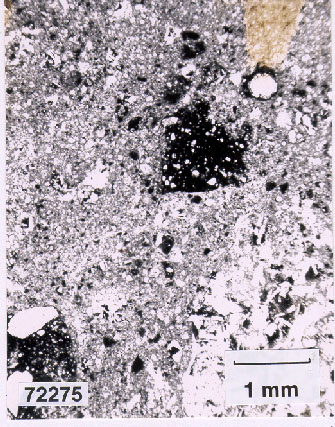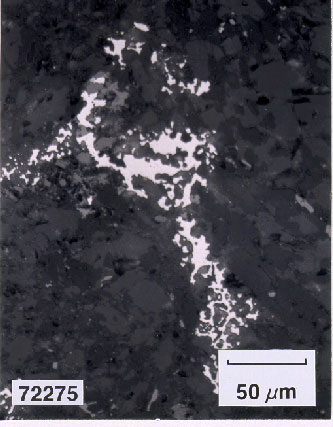
BRIEF DESCRIPTION OF 72275
| Lunar Sample Compendium Link | Lunar Sample Catalog Link | Open University Virtual Microscope Link |
Lunar sample 72275 is a friable feldspathic breccia with an aphanitic matrix that was chipped from a boulder within a landslide from the South Massif at the Apollo 17 site. This sample has a wide variety of clast types derived from the lunar highlands (Stoeser et al. 1974). It doesn’t contain any of the high-Ti mare material found at the Apollo 17 site. The composition of this rock is given in table 6.
Matrix - Portions of the light friable matrix of sample 72275 are very porous (5 to 30 percent). The major mineral in the matrix is feldspar. This sample has a breccia-in-breccia texture where clasts of darker microbreccia are included in the light feldspathic matrix (fig. 52). The darker areas have a higher percentage of fine matrix to clasts.
Glass - This sample is glass poor. Much that appears to be glass is really maskelynite (shocked plagioclase) or void. Void spaces are filled with epoxy and can be best detected by checking in reflected light.
Opaques - Many small grains of disseminated metallic Fe and troilite are in portions of this sample. In some thin sections, the Fe in the silicate minerals is in the process of being reduced to metal (fig. 53). The cause for this reduction is unknown. Very little ilmenite is present.

Figure 52. Breccia-in-breccia texture of fragmental breccia 72275. This sample is feldspar rich. Note the clast of pigeonite basalt in this section.

Figure 53. Spongy mass of troilite and Fe are abundant in the matrix of 72275.
Lithic clasts - Look for subophitic basaltic clasts with felty white plagioclase laths and yellow pyroxenes that are included in some thin sections of this breccia. These are termed pigeonite basalts. There are some clasts of annealed plutonic rocks. These include plagioclase-rich granulitic breccias and cataclasites. These clasts have polygonal interlocking plagioclase and olivine with grain size about 100 microns and 120 deg interfacial angles. Small felsite clasts with intergrown K-feldspar and silica are also in some thin sections of this breccia. There are no clasts of mare basalt.
Petrogenesis - This is a polyrnict breccia derived from a variety of highly reworked highland rocks. The clast distribution in sample 72275 is different from the poikilitic breccias found on the North Massif. The presence of clasts with fine subophitic basalt texture indicates that at least part of sample 72275 was derived from near the lunar surface. The relationship of Apollo 17 breccias to their source of origin in the ejecta from the large lunar basins was discussed by Spudis and Ryder 1981. Can both types of breccia be Serenitatis ejecta?
